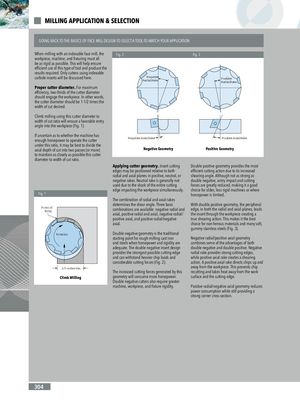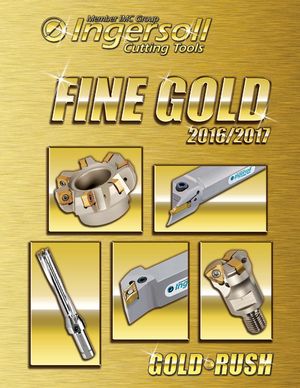Общий каталог Ingersoll 2011 - страница 302
Навигация
- 0003 Table of Contents
- 0006 End Mills
- 0064 Long Edge
- 0104 0Deg Face Mills
- 0160 Face Mills
- 0202 Slotters
- 0218 Form Mills
- 0236 Profile Mills
- 0302 Milling Tech
- 0384 Solid Carbide
- 0448 Solid Carbide Tech
- 0474 Holemaking & Thread Milling
- 0666 Holemaking & Thread Milling Tech
- 0720 Innofit Top On Toolholders
- 0738 HSK Toolholders
- 0774 CAT Toolholders
- 0796 BT Toolholders
- 0816 Adaptions Accessories
- 0872 Turning Inserts
- 1024 Turning Holders
- 1144 Turning Tech
- 1174 Threading Inserts
- 1242 Threading Holders
- 1256 Threading Tech
- 1268 T-Clamp
- 1344 T-Clamp Tech
- 1376 T-CAP
- 1388 T-CAP Tech
- 1394 Product_Index

MILLING APPLICATION & SELECTION GOING BACK TO THE BASICS OF FACE MILL DESIGN TO SELECT A TOOL TO MATCH YOUR APPLICATION When milling with an indexable face mill, the Fig. 2 Fig. 3 workpiece, machine, and fixturing must all be as rigid as possible. This will help ensure efficient use of this type of tool and produce the results required. Only cutters using indexable carbide inserts will be discussed here. NegativeRadial Rake PositiveRadial Rake Proper cutter diameter. For maximum efficiency, two-thirds of the cutter diameter should engage the workpiece. In other words, the cutter diameter should be 1-1/2 times the width of cut desired. Climb milling using this cutter diameter to width of cut ratio will ensure a favorable entry angle into the workpiece (Fig. 1). If uncertain as to whether the machine hasenough horsepower to operate the cutterNegative Axial Rake Positive Axial Rake under this ratio, it may be best to divide the axial depth of cut into two passes (or more) Negative Geometry Positive Geometry to maintain as closely as possible this cutter diameter to width of cut ratio. Applying cutter geometry. Insert cutting Double positive geometry provides the most edges may be positioned relative to both efficient cutting action due to its increased radial and axial planes in positive, neutral, or shearing angle. Although not as strong as negative rakes. Neutral rake is generally not double negative, entry impact and cutting used due to the shock of the entire cutting forces are greatly reduced, making it a good edge impacting the workpiece simultaneously. choice for older, less rigid machines or where Fig. 1 horsepower is limited. The combination of radial and axial rakes determines the shear angle. Three basic With double positive geometry, the peripheral Point ofEntry combinations are available: negative radial and edge, in both the radial and axial planes, leads axial, positive radial and axial, negative radial/ the insert through the workpiece creating a positive axial, and positive radial/negative true shearing action. This makes it the best axial. choice for non-ferrous materials and many soft, gummy stainless steels (Fig. 3). Rotation Double negative geometry is the traditional starting point for rough milling cast iron Negative radial/positive axial geometry and steels when horsepower and rigidity are combines some of the advantages of both adequate. The double negative insert design double negative and double positive. Negative provides the strongest possible cutting edge radial rake provides strong cutting edges, and can withstand heavier chip loads and while positive axial rake creates a shearing considerable cutting forces (Fig. 2). action. A positive axial rake directs chips up and 2/3 cutter dia. away from the workpiece. This prevents chip The increased cutting forces generated by this recutting and takes heat away from the work Climb Milling geometry will consume more horsepower. surface and the cutting edge. Double negative cutters also require greater machine, workpiece, and fixture rigidity. Positive radial/negative axial geometry reduces power consumption while still providing a strong corner cross-section. 304
 Общий каталог Ingersoll 2016 - 2017
Общий каталог Ingersoll 2016 - 2017 Общий каталог Ingersoll 2014
Общий каталог Ingersoll 2014 Каталог Ingersoll инструмент для нарезания резьбы
Каталог Ingersoll инструмент для нарезания резьбы Общий каталог Ingersoll 2013 - 2014
Общий каталог Ingersoll 2013 - 2014 Каталог Ingersoll новинки 2021
Каталог Ingersoll новинки 2021